Exhibition tour
A Long Time Ago, but Still so Close: Castles and Pre-industrial Life (Rooms 2, 5-7)

Space and time provide the framing for historical events. Each and every one of us is moving within this framework and is therefore a part of history. Therefore, the first key topic of the permanent exhibition provides for familiarisation with the very specific characteristics of space and time that played a role for Wewelsburg Castle and for the people in the district of Paderborn.
Wewelsburg Castle itself is the most important exhibit of this museum and at the same time an extremely multi-layered one. Given its name, it triggers expectations associated with images of medieval knight’s castles. It was, however, built much, much later, in the early 17th century, and specifically as a “firm castle”. The numerous images we have in mind regarding the Middle Ages and their castles also play a role – most of the time hardly related to the “real” medieval times. These images of an epoch a long time ago are being examined and challenged by the objects and pictures in the first room.
Time and the way in which we experience it also separate us from our ancestors. Natural cycles and religious holidays structured the time and the work processes of the people prior to industrialisation. Nowadays, however, exactly measured durations that are as short as possible and utilised effectively constitute the reality of life. A highly diverse multitude of exhibits tells about these different experiences of time.
Wewelsburg Castle (Rooms 8 and 9)
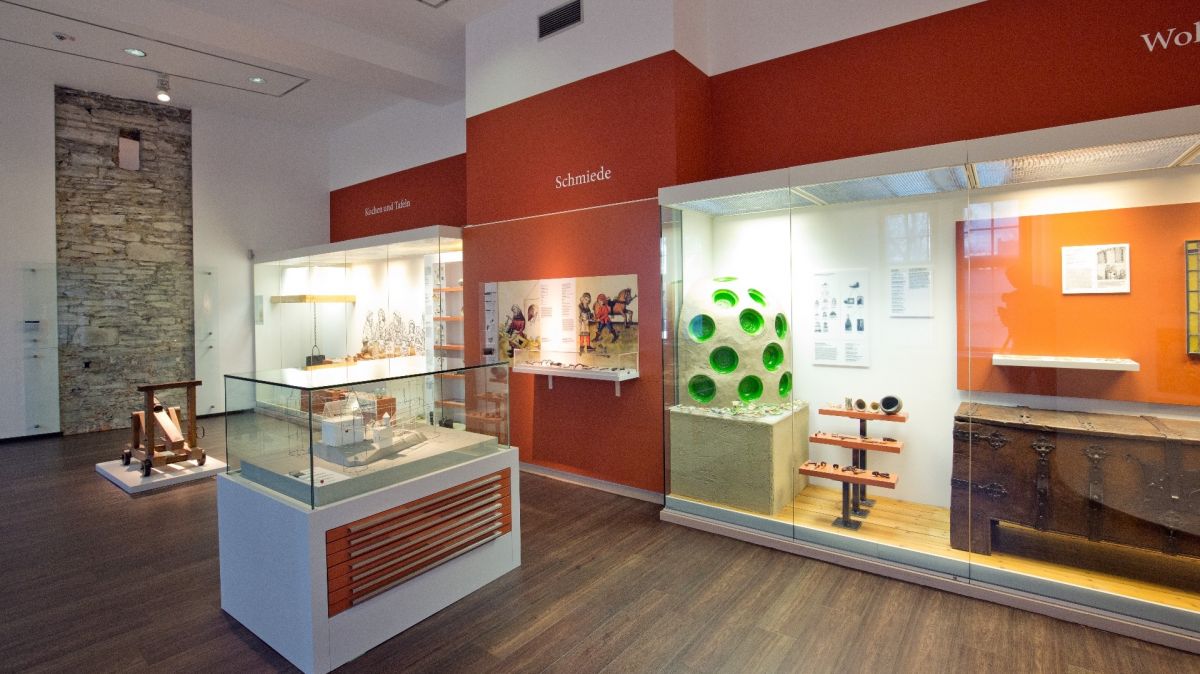
Due to its closed triangular shape maintained to date, Wewelsburg Castle stands out amount the palatial buildings of Germany. This shape is raising numerous questions: Why did the architect choose it? Who was the owner of the castle and what objectives did he pursue with its construction? How was this special facility used later on? Starting with a large model of the castle and many other objects, these questions are answered on the upper floor of the southeast tower.
The location in which Wewelsburg Castle was erected 1603 to 1609 already was built-up previously. A medieval castle facility in the possession of the bishops of Paderborn can be traced back as far as into the 12th century. Due to comprehensive excavation in the inner courtyard of Wewelsburg Castle, it was possible to reconstruct the life of its inhabitants. Numerous finds from there can be viewed in this part of the permanent exhibition. At the same time, a look behind the current wall covering is worthwhile, here: A part of the masonry of a medieval residential tower that was integrated into the construction of Wewelsburg Castle has been exposed here.
A Journey through the History of the Prince-Bishopric of Paderborn (Room 10)

The journey starts in the Mesolithic, approx. 80,000 years ago, at the first human traces in the area of the later Prince-Bishopric of Paderborn. It tells the story of how the Neolithic humans settled down and buried their dead in, among other ways, the cist graves typical of this region. Then, the other epochs of prehistoric and early history that left their traces behind are covered. In addition to finds from the Bronze Age and Iron Age, these include impressive items from the former Roman camp Anreppen at the Lippe river near Delbrück around 5 AD.
The medieval portion of the journey tells us about the conquering and conversion of the Saxons by Charlemagne, the importance of the bishops of Paderborn for the Christianisation, and their role as secular sovereigns with the Prince-Bishopric as a territory of their own. Important bishops, such as Meinwerk and Rotho, are being introduced. And a sword discovered in the Afte River near Büren provides new life to the “times of the knights”.
In the section regarding the Early Modern Age, historical maps invite the travellers to find their way through the Prince-Bishopric of Paderborn in the fashion of the 17th and 18th century. Back then, the modern mapping of the current Westphalia started. The religious and military conflicts of the 16th to 18th centuries with the passed-on objects and graphics constitute the next section of the journey. It ends with the abolition of the Prince-Bishopric of Paderborn in 1802 by Napoleon and provides an outlook on what took the place of the Prince-Bishopric.
The Clergy, Religiousness, and the Nobility (Rooms 11 and 12)
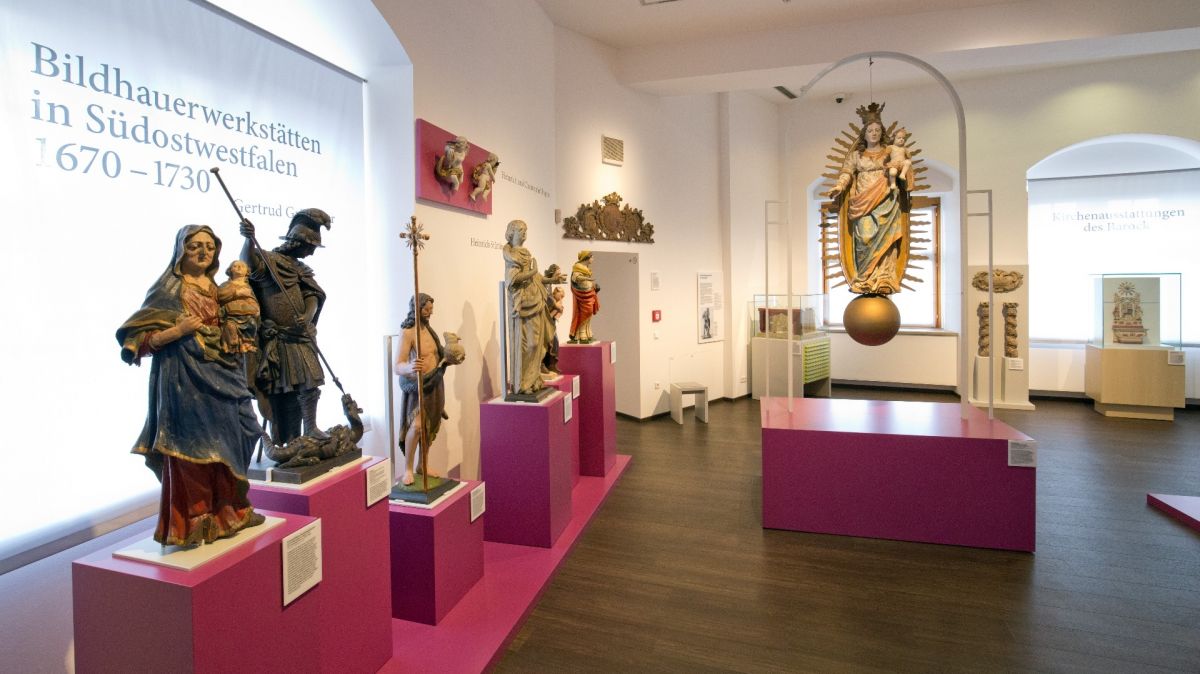
At the top of the clerical territorial lordship was the prince-bishop, important positions were filled by clerics. Through the Council of Trient, which was intended to strengthen Catholicism subsequent to the reformation, the training and general level of education of the clerics was improved and standardised. This development can, for example, be traced based on the reconstructed library of a pastor from this age and based on the scholastic historic works of prince-bishop Ferdinand von Fürstenberg.
A separated room is dedicated to the (self-)portrayal of the nobility at the Prince-Bishopric of Paderborn. Portraits of noblemen, artistically designed funerary monuments that were intended to preserve the memory of the deceased persons in a special way, and precious fashions provide an impression of the importance of this social class at the Prince-Bishopric. This is also reflected in a selection of valuable collector’s items being presented in the middle of this room.
The furnishings of the churches and the visual appearance of liturgy and piousness in the age of the “Catholic reform” featured splendor and theatricality. Select examples of sacral figural sculptures provide an impression of the work of East Westphalian sculptors’ workshops of the 17th and 18th century. Items for worship service are on display that provided for a major visual effect. The populace worshipped the saints in the form of images on devotional pictures and reverse paintings on glass, or entrusted themselves to them in the form of processions and intense preparations for a good hour of death.
The conclusion of this department of the museum is formed by textiles from former Jewish congregations of the Prince-Bishopric, for example from Warburg. The model of a synagogue exemplarily explains the furnishings of these focal points of Jewish community life.
Stadt und Bürger (Räume 13-15)
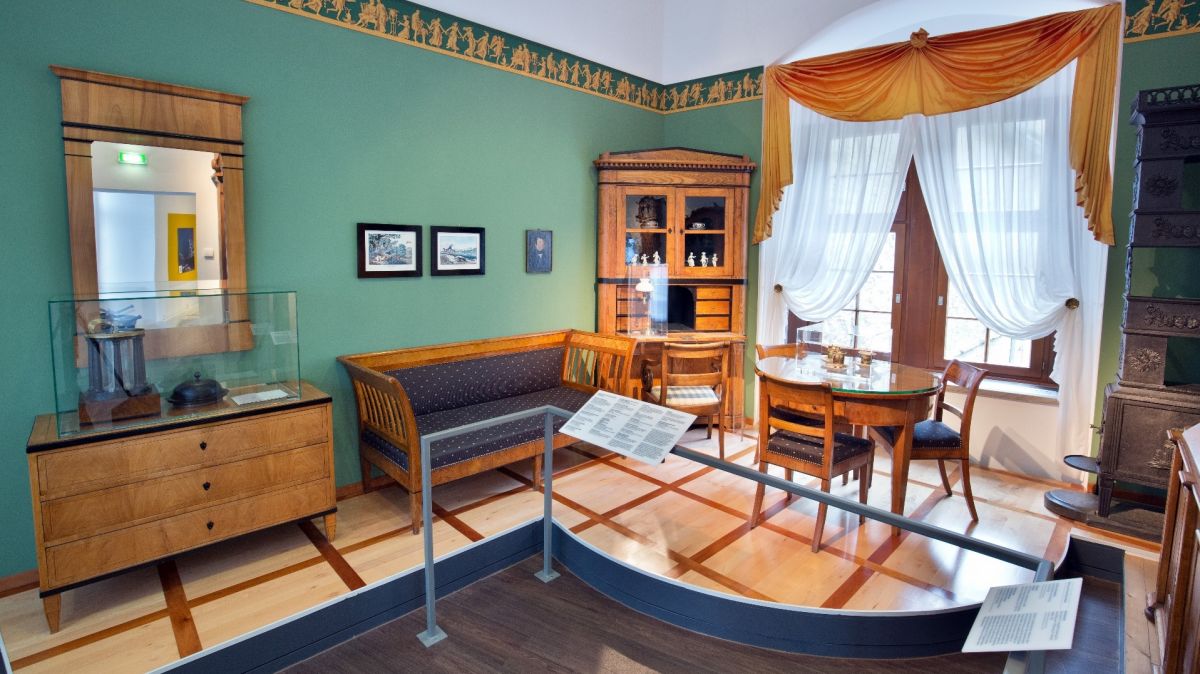
At the end of the Middle Ages, there were 23 cities in the Prince-Bishopric of Paderborn – a comparatively large number for the circumstances back then and in relation to the size of this territory. The bishops founded cities for economical, strategic, or military reasons. The different facets of life in these urban communities, e.g. “to build and live”, “fire hazard and water supply”, or “trade and money” are the topic of this section.
Bourgeois domestic culture around 1800 based on two original furniture ensembles from the Prince-Bishopric is the topic of another room. Here, we are displaying – as a prominent exhibit – also a pattern book that was in use from the 17th until the early 19th century and contains patterns and drafts for interior decors and furniture.
Next, the talk is about a city that disappeared, a late medieval deserted town from the area between Lichtenau and Warburg. Blankenrode existed only for about 150 years before it perished. But since no new construction ever took place in this area, it was still possible to make numerous finds. The latter and a media station provide information regarding the colonisation of Blankenrode and the reasons for its disappearance.
The Land, Peasants and Farmers (Rooms 16-19, 22)

Despite a relatively far developed urban landscape, the Prince-Bishopric was, in the Middle Ages and in the Early Modern Age, characterised significantly by life in the rural area. Agriculture constituted the livelihood of the people. Its development and the importance of agriculture for the working conditions and the living of the people are presented here. The “five-field system” and the construction of a rural half-timbered home are being explained here, as well. A richly equipped dowry from the late 18th century includes the multitude of early modern period household equipment and at the same time illustrates in which way wealth was displayed outwardly in rural society.
In the forest, the economic interests of the rural populace and of the privileged classes encountered one another. Therefore, this part of the rural area was subject to intense and conflict-ridden utilisation. Historic tools, hunting weapons, and image sources provide insight into the role of the forest as wood supply, hunting ground, and pasture.
Natural History (Rooms 20, 21 and 25)

The dominant landscape features in the area of the former Prince-Bishopric and their formation are the central questions of the natural history department. Subsequent to a tour regarding typical landscape characteristics of this region, such as distinctive elevations caused by volcanic activity, or limestone plateaus rich in crevasses, you can descend into the depths of those epochs of the history of earth that produced these landscape characteristics.
Those include the Ice Ages with the impressive bone finds of the woolly rhinoceros and the mammoth originating from this epoch. But an insight into the Cretaceous period is provided as well, when about 100 million years ago a flat tropical sea with its sediments created the foundation of today’s Paderborn plateau.
Social Outcasts and Mobility (Rooms 23, 24 and 26a)
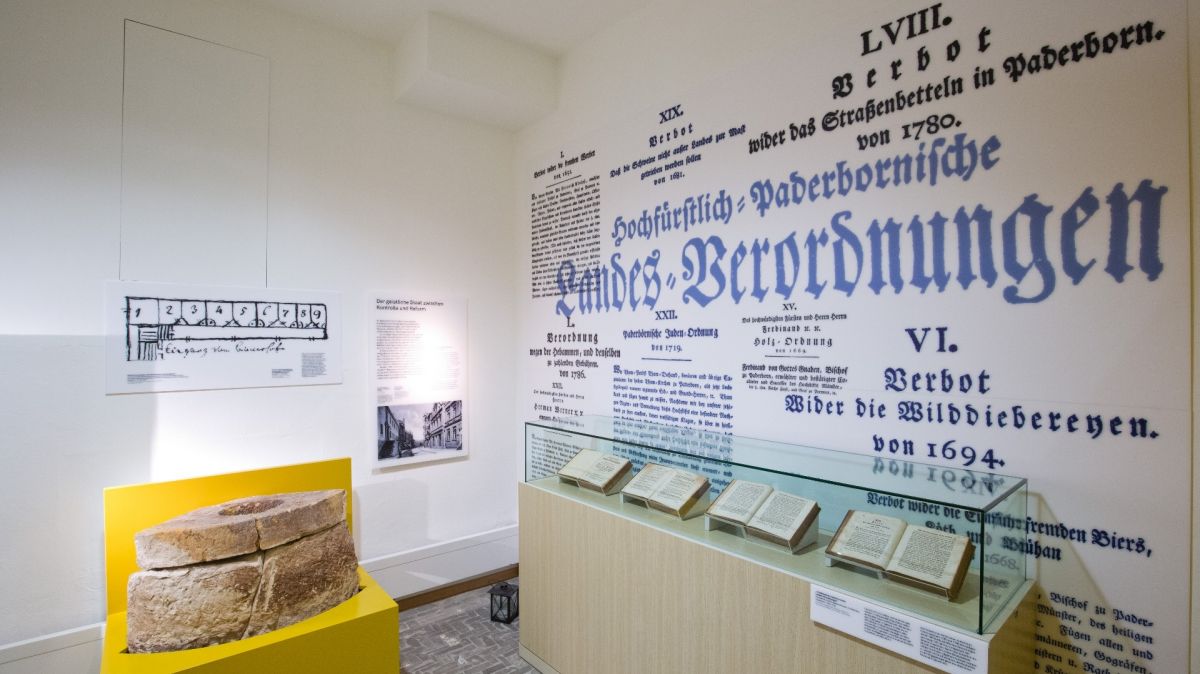
At the Prince-Bishopric of Paderborn, it took until the 18th century until the border to the neighbouring landgraviate Hesse was set in stone. Historic boundary stones and the reproduction of a contemporary map illustrate this prolonged process.
Along with the establishment of borders for the territory came the definition of its subjects and the exclusion of other groups. In the eyes of the state authorities, they could appear culturally different, damaging, or criminal. Sinti and Jews, in particular, were suffering from the corresponding restrictions and discriminations. A “gipsy pole” and documents of the rejection of Jews in the Prince-Bishopric of Paderborn are evidence of this view of the Early Modern Age state regarding certain social groups.
A unique object is shedding light on the legally very weak position of sub-peasant classes towards nobility in the late 18th century. Based on the example of the 250-year old, but excellently preserved jacket of the cow herder Hans Cord Marx, called “Plöger”, the story of his dispute with the landowner von Reden, his deadly injury by this nobleman, and the processing of this case in court are being told.
Despite the territorial borders, the latest in the 18th century a supraregional network of pathways with postal routes for letter and personal traffic was essential also to the Prince-Bishopric of Paderborn. Via these routes, migrant workers and tradespeople reached the Paderborn region and influenced its economy. Historic maps, an old telemeter, and graphics with illustrations of typical itinerant trade bear witness of this development. But a section of the original Hellweg indicates that already many centuries earlier supraregional traffic pathways through the Prince-Bishopric existed.
Security and Order (Rooms 3, 4 and 26b)
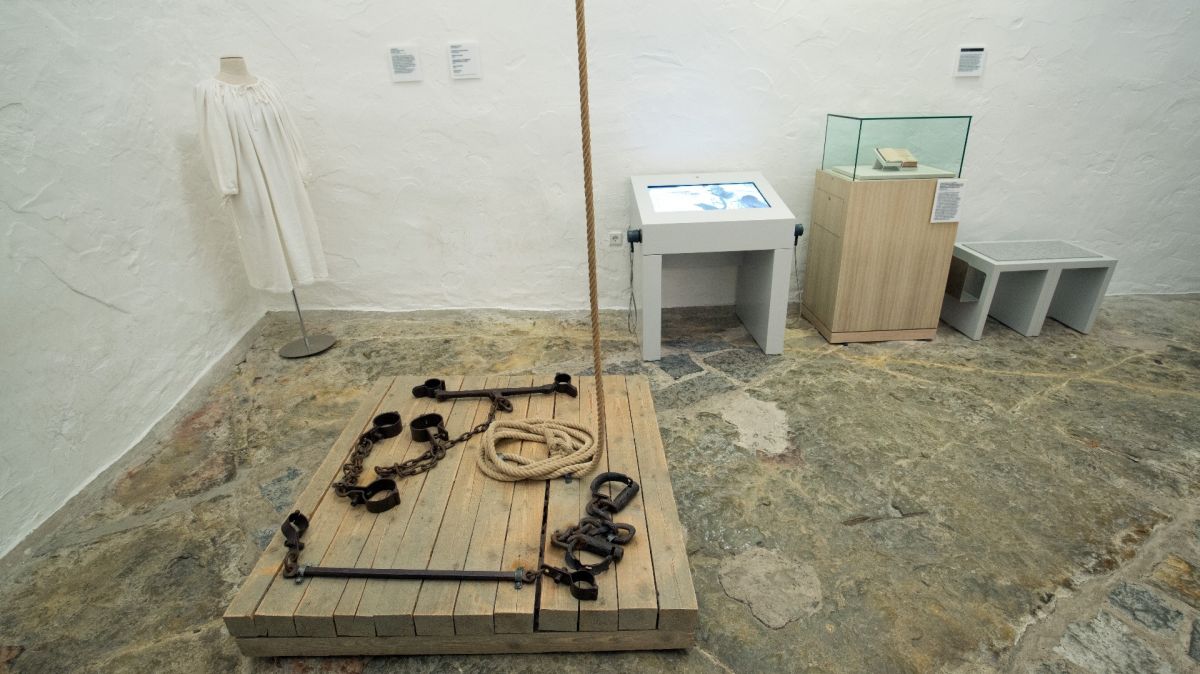
Security and order constituted decisive terms of the Early Modern Age state. Its inhabitants were to be raised to become good subjects. A large format collage of “State ordinances of the Prince-Bishopric of Paderborn” from the period around 1780 illustrates the efforts of the state authorities to control their subjects in day-to-day life and to marginalise undesirable outsiders. In case of resistance, the jail became the location where the state forcibly attempted to re-educate – and this under, in part, disgraceful conditions, as can be seen on the example of the original of a latrine from an arrest cell at the former Prince-Bishopric chancellery in Paderborn.
The witch trials in the Prince-Bishopric of Paderborn constituted a special form of the persecution of subjects. This gruesome chapter from the history of the Prince-Bishopric is exmined at the original location of two interrogations of alleged witches in Wewelsburg Castle, the so-called “Witches’ Cellar”.
The military of the Prince-Bishopric also stood in the service of police order. This was illustrated, for example, during the Paderborn “Coffee hubbub” of 1781 when the prince-bishop deployed the Neuhaus company against those subjects who insisted on enjoying their coffee. A tin figure model is narrating this intriguing story. Beyond that, the deployments of the Paderborn military primarily occurred in foreign wartime service for the Reich, including in the Seven Years’ War. Historic battle plans and – in a listening station – Colonel Friedrich Anna Ewald von Kleist, back then commander of the infantry battalion of Paderborn, report of this.
Security also played an important role for certain branches of craft trades, among them the blacksmith’s trade’s work with fire. The museum features the original blacksmith equipment of the Balkenhol blacksmith’s shop from Bleiwäsche near Bad Wünnenberg. It was operated from the beginning of the 19th century until the second half of the 20th century and, in the exhibition, nowadays provides once more a feeling for this craft trade work and its formerly great importance – at special events even in the form of actual demonstrations.
Rural Handicraft and Pre-Industrial Production (Rooms 27-29)
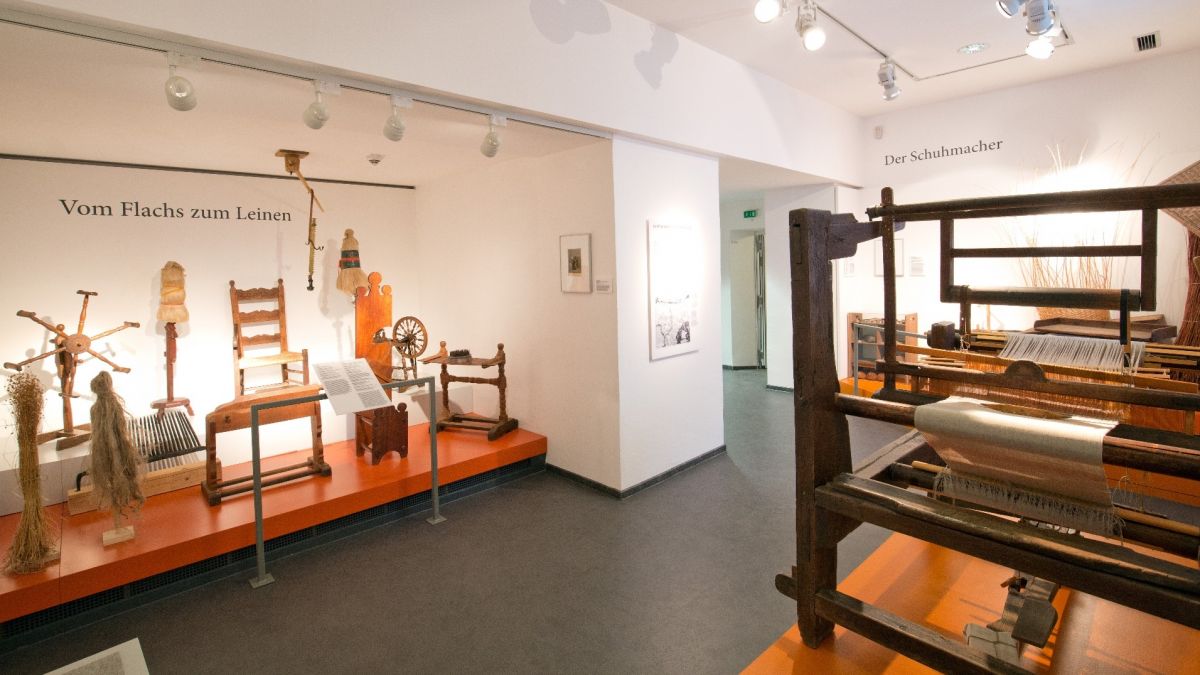
Outside of the guilded trades of the cities, there also was a multitude of branches of handicraft in rural areas in the Prince-Bishopric of Paderborn which were of fundamental importance for a functioning of the farmers’ way of conducting business. As examples, the exhibition is presenting the shoemaking craft, basketry, the manufacturing of fabrics, and the traditional technique of blueprinting. But technical skill and inventiveness were also in demand at each individual farm, e.g., when it came down to food storage, several methods of which are being presented.
A pre-industrial manufacture of goods existed only in select cases in the Prince-Bishopric of Paderborn. In Altenbeken, near the Egge mountains, iron was extracted for centuries and processed into stove plates. This “Altenbeken Specialty” is demonstrated by various ovens in the permanent exhibition. The glassworks of the region also achieved great artistry in the 18th century, especially the glassworks of Emde near Brakel. The ample supply of raw materials for glass production available here was, among other things, processed into valuable covered goblets which were sold to an exclusive circle of customers. The museum features impressive examples of this art of glassmaking which constitute the conclusion of this tour.
Address
Kreismuseum Wewelsburg
Burgwall 19
33142 Büren-Wewelsburg
Germany
Contact
Phone 02955 7622-0
Fax 02955 7622-22
nfwwlsbrgd
Contact form
Informative
Wewelsburg





